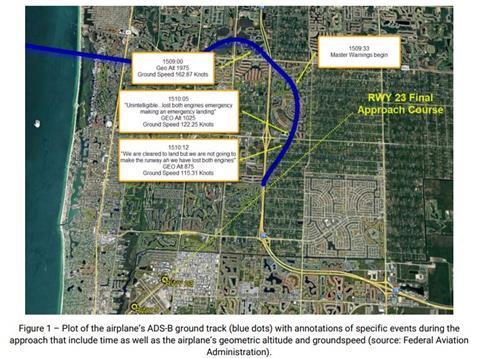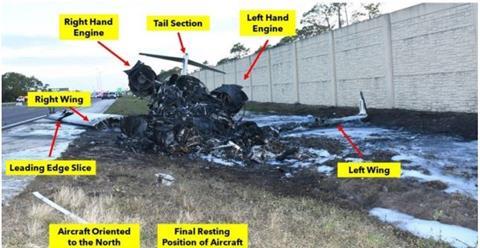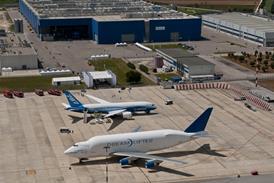Pilots of the Bombardier Challenger 604 that crashed on a Florida highway on 9 February received low oil pressure warnings for both engines moments before they reported that both powerplants failed.
That is according to a preliminary report from the National Transportation Safety Board (NTSB) about the accident, which killed both pilots. Two passengers, the cabin attendant and one person on the ground suffered minor injuries.
While mentioning the oil-pressure problem, the NTSB provides few other clues about caused the accident. The pilots, after reporting a dual engine failure to air traffic control, brought the jet down on Interstate 75 near Naples Municipal airport in southwest Florida.

The NTSB’s report notes that the crash scene was soaked with fuel.
Operated by Ace Aviation Services under the business name Hop-A-Jet, the Challenger (registration N823KD) took off from The Ohio State University airport in Columbus, Ohio, bound for Naples. Hop-A-Jet could not be reached for comment.
Prior to departing Columbus, the twin GE Aerospace CF34-powered Challenger had been filled with 350gal of fuel, says the NTSB.
At 15:08 local time, the Naples control tower cleared the Challenger to land on runway 23. The NTSB says the pilots flew the downwind leg of the traffic pattern and then turned on the base leg, meaning they had one final turn to line up with runway 23. While on the base leg, the jet was at about 2,000ft altitude, about 10.5km (6.5 miles) from the airport and flying at 166kt (307km/h).
At 15:09 the pilots received three master warnings in the cockpit – one “Engine Oil Pressure” warning each for both the left and right engines, and one separate “Engine” warning, according to the NTSB.
Meanwhile, the pilots turned to line the jet up for runway 23. Moments later, at 15:10, one of the pilots said, “Lost both engines… emergency… making an emergency landing”, according to the report. At that time, they were at about 1,000ft, flying at 122kt and headed toward the runway on a course that would have crossed over Interstate 75.
“We are cleared to land but we are not going to make the runway,” one of the pilots said. “We have lost both engines.”
Air traffic controllers received no further transmissions from the aircraft, which then crashed onto Interstate 75.
Video recorded by automobile dash-cams show that the “airplane descended… in a shallow left turn and then leveled its wings before it touched down aligned with traffic travelling the southbound lanes of Interstate 75,” the NTSB says.
The jet’s left main landing gear came down first and in the centre of three lanes, after which the right main gear came down in the right lane.
“The airplane continued through the breakdown lane and into the grass shoulder area before impacting a concrete sound barrier. The airplane was obscured by dust, fire, smoke and debris until the video ended,” says the report.
The jet came to rest about 1,000ft past the point it first touched down.

Video taken from the scene appears to show passengers escaping the flaming wreckage.
The NTSB says the jet’s forward fuselage had been consumed by fire and that the ground near the wreckage was “fuel soaked”. It adds that investigators found the throttles in the “idle stop position” and the flap lever set to a 45° extension.
The pilots were both experienced, with the captain having logged 10,545h of flight time, including 2,808h in Challenges. The first officer had accumulated 24,618h of total time, including 138h in Challengers.


























